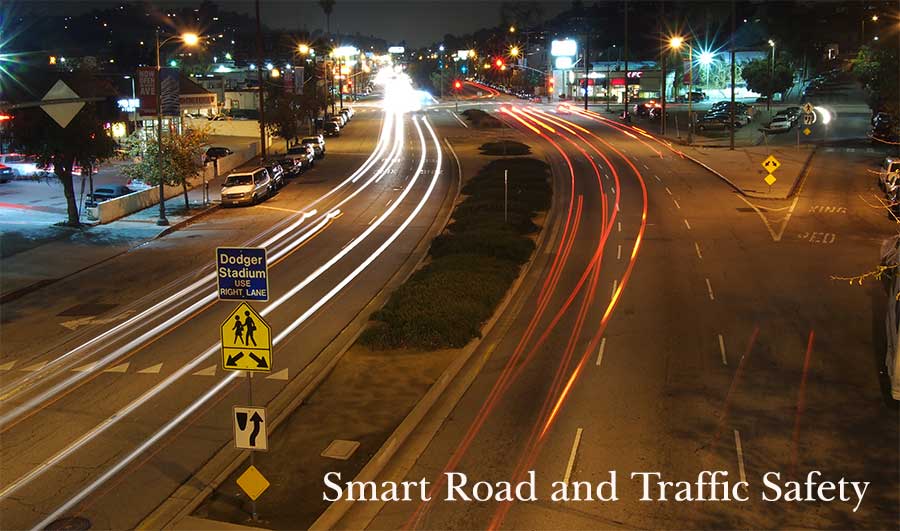Smart Road and Traffic Safety: The Future of Transportation
As our cities and communities continue to grow and expand, the need for effective transportation solutions has become increasingly important. With millions of vehicles on the road each day, traffic safety has become a pressing concern. The development of smart road and traffic safety technologies has the potential to transform the way we move and commute, making our roads safer, more efficient, and more sustainable. In this article, we will explore the concept of smart road and traffic safety, the challenges and opportunities it presents, and its potential impact on the future of transportation.
Traffic congestion is a growing problem in many parts of the world, leading to increased air pollution, decreased productivity, and frustration for drivers. Roads can take a long time to reach capacity; once they do, it can be difficult to alleviate the problem. However, smart roads can help solve this problem by using advanced technologies to monitor and control traffic flow.
Smart roads can collect real-time information about traffic flow and use this data to optimize traffic patterns. This can be achieved by using cameras, sensors, and other high-tech equipment to detect traffic speed, direction, and flow and provide information to a central system. This information can then be used to adjust the timing of traffic lights, direct drivers to alternative routes, and provide real-time updates to drivers through in-car navigation systems or mobile applications.
In addition to improving traffic flow, smart roads can also help improve road safety. For example, intelligent cameras can detect dangerous driving behaviors, such as speeding, reckless driving, and tailgating, and provide alerts to drivers or law enforcement. This can help to reduce the number of accidents and improve road safety for all users.
Smart roads can also play a key role in reducing the environmental impact of transportation. By reducing the time vehicles spend on the road, the technology can help reduce air pollution and greenhouse gas emissions, leading to a more sustainable transportation system. Additionally, smart roads can be designed to be more energy efficient, using renewable energy sources, such as solar panels, to power the technology.
Another key benefit of smart roads is the potential to reduce the cost of transportation. By improving the safety of traffic, reducing the number of accidents, and reducing the time vehicles spend on the road, the technology can help reduce fuel consumption and maintenance costs, leading to cost savings for drivers and transport companies.
Integrating smart roads with autonomous vehicles is also a major development area. Autonomous vehicles rely on real-time information about the road network, and smart roads can provide this information through sensors, cameras, and other high-tech equipment. This information can help improve the safety and efficiency of autonomous vehicles and provide valuable data for developing self-driving technologies.
There are many examples of smart roads in use around the world, and their success has led to increased investment in this technology. For example, in Europe, the deployment of smart roads has been a key part of the European Union’s plans to improve the efficiency of its transportation system. The Department of Transportation has invested heavily in smart roads in the United States to improve road safety and reduce congestion.
One example of a successful smart road project is the M25 London Orbital Motorway in the United Kingdom. This project saw the deployment of smart technologies along the motorway, including cameras, sensors, and electronic road signs, which have helped to reduce congestion, improve road safety, and increase travel speed for drivers. The success of this project has led to the deployment of smart roads in other parts of the country, and it has inspired similar projects around the world.
What is Smart Road and Traffic Safety?
Smart road and traffic safety refers to the use of advanced technologies and data analytics to improve the safety and efficiency of our roadways. It encompasses a range of technologies, including sensors, cameras, and other IoT (Internet of Things) devices that can collect and analyze data about traffic flow, vehicle movement, and road conditions. This data can then be used to optimize traffic management, reduce congestion, and enhance safety on the road.
The development of smart road and traffic safety technologies is driven by various factors, including the need to reduce traffic accidents, improve air quality, and promote sustainable transportation. It is also being driven by advances in technology, including the growing availability of low-cost sensors, the increasing power of computing and data analytics, and the development of connected and autonomous vehicles.
The Challenges and Opportunities of Smart Road and Traffic Safety
The development of smart road and traffic safety technologies presents challenges and opportunities for the transportation industry. On the one hand, there are a range of technical and logistical challenges associated with deploying and managing these technologies. These include data privacy and security issues, the need for standardization and interoperability, and the challenge of integrating these technologies with existing infrastructure.
On the other hand, significant opportunities are associated with developing smart road and traffic safety technologies. These include the potential to reduce traffic accidents and fatalities, improve traffic flow and reduce congestion, and promote sustainable transportation. They also include the potential to create new business opportunities, stimulate economic growth, and enhance the quality of life for citizens by creating safer and more efficient transportation networks.
The Role of Data Analytics in Smart Road and Traffic Safety
At the heart of smart road and traffic safety technologies is data analytics. By collecting and analyzing data about traffic flow, vehicle movement, and road conditions, transportation authorities can gain valuable insights into the performance of their transportation networks. This can enable them to optimize traffic management, reduce congestion, and improve safety on the road.
One area where data analytics is particularly important is in the development of predictive models for traffic flow. By analyzing historical traffic data, transportation authorities can identify patterns and trends in traffic flow and use this information to develop predictive models that can anticipate future traffic conditions. This can enable them to take proactive measures to manage traffic flow, such as adjusting traffic light timings or diverting traffic to alternative routes.
Data analytics can also be used to optimize traffic management in real time. Transportation authorities can monitor traffic flow and adjust traffic management systems in real-time to reduce congestion and improve safety by collecting data from sensors and other IoT devices on the road. This can include adjusting light traffic timings, changing speed limits, or providing real-time traffic updates to drivers.
Another area where data analytics is important is in the development of safety systems for connected and autonomous vehicles. By collecting data from a range of sensors and cameras on the vehicle, these systems can detect potential hazards on the road and take action to prevent accidents. For example, they can apply the brakes automatically if a vehicle ahead suddenly stops or provide real-time alerts to drivers about potential hazards on the road.
The Potential Impact of Smart Road and Traffic Safety
The potential impact of smart road and traffic safety technologies is significant. By reducing traffic accidents and improving traffic flow, these technologies have the potential to save lives, reduce costs, and enhance the quality of life for citizens. They also have the potential to promote sustainable transportation by encouraging the use of alternative modes of transportation, such as public transit, bicycles, and walking.
In addition to these benefits, smart road and traffic safety technologies also have the potential to create new business opportunities and stimulate economic growth. Developing and deploying these technologies requires significant investment in research and development, infrastructure, and workforce training, creating new jobs and economic activity. It also creates opportunities for innovation in areas such as data analytics, sensor technology, and autonomous vehicles.
Traffic Safety and IA relationship
Another application of AI in traffic safety is in the field of predictive analytics. By analyzing large datasets on traffic patterns, weather conditions, and driver behavior, transportation authorities can predict where accidents are likely to occur and take steps to prevent them. For example, they can deploy additional traffic police or adjust traffic signals to reduce the likelihood of accidents at certain intersections. This approach has been used in several cities around the world, including New York City and London, with promising results.
AI can also be used to improve traffic flow and reduce congestion on the road. By analyzing real-time traffic data, transportation authorities can identify bottlenecks and take steps to alleviate them, such as adjusting traffic signal timings or rerouting traffic. This approach has been used in several cities around the world, including Singapore and Los Angeles, with promising results. By reducing congestion, these technologies can reduce emissions and improve air quality, promoting sustainable transportation and enhancing the quality of life for citizens.
Traffic Safety and digital city
One key aspect of a digital city approach to traffic safety is the use of data analytics to monitor traffic patterns and identify potential hazards. By collecting and analyzing real-time data on traffic flow, accidents, and road conditions, transportation authorities can identify areas where improvements are needed and take action to prevent accidents. For example, they can adjust traffic signals, deploy additional traffic police, or reroute traffic to alleviate congestion.
Another key aspect of a digital city approach to traffic safety is the use of connected vehicle technology. Connected vehicles are equipped with sensors and communication devices that allow them to communicate with each other and with the transportation infrastructure. This technology enables real-time monitoring of traffic flow and road conditions and communication between vehicles to improve safety. For example, if a vehicle detects a hazard on the road, it can send an alert to other vehicles in the area to warn them and help prevent an accident.
Another important aspect of a digital city approach to traffic safety is the integration of public transportation and alternative modes of transportation, such as bicycles and walking. By promoting the use of alternative modes of transportation, transportation authorities can reduce congestion on the road and improve safety for all road users. For example, they can create dedicated bike lanes or pedestrian zones or provide incentives for the use of public transportation.
HTN’s contribution is aiming at traffic flow improvement and roadway productivity by integrating AI and IoT technologies combined with ADAS technologies.



